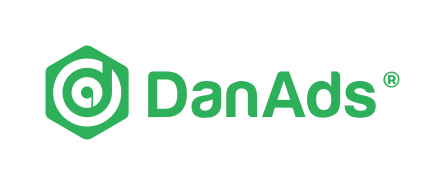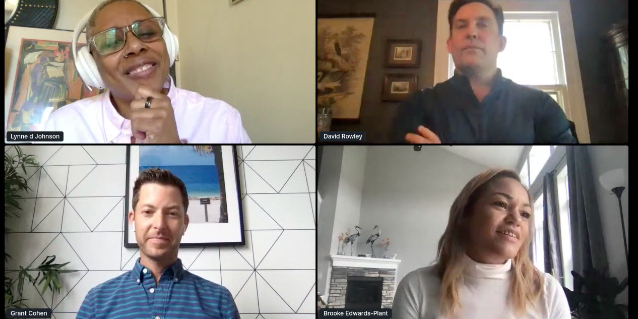- “(DanAds) tool is really a way for us to provide a scaled opportunity for all the longer tail publishers in our platform to really get distribution and reach amongst our installed base of Roku devices” – Grant Cohen, Roku
- “DanAds was able to work with us on those learnings and think about the long term success and adoption within the marketplace for self serve” – Allison Lambroza, Tripadvisor
- “Everyone on the DanAds team really is super helpful in that regard, really just bucketed bullet list of what you need to accomplish” – David Rowley, Advance Local
- “We want to make sure that the sales team is freed up to think about larger partnerships and larger deals and isn’t bogged down with smaller deal sizes, and we also want to be able to create some automation so that you don’t have as many people required internally to turn around these deals” – Brooke Edwards-Plant, The Atlantic
Lynne D Johnson (AdMonsters): All right, so hi, everyone. We’re here to talk about self serve to the rescue. Many of you are in different stages of adopting self serve. We have, Brooke, from the Atlantic. David Rowley, who now has his own company Bootleg, formerly at Advance Local, Allison Lambroza from Tripadvisor, and Grant calling from Roku. So I guess what I want to first know is what problem were you trying to solve when you first looked at bringing in self serve as an option? Brooke, I’d like to talk to you because you’re really new in this journey, so I’d like to talk to you about that.
Brooke Edwards-Plant (The Atlantic): So we’re just currently at the onboarding stage. And one of the problems we’re really trying to solve for is resource management. We want to make sure that the sales team is freed up to think about larger partnerships and larger deals and isn’t bogged down with smaller deal sizes, and we also want to be able to create some automation so that you don’t have as many people required internally to turn around these deals.
Lynne D Johnson (AdMonsters): Right. And David, what was it like for you guys?
David Rowley (Advance Local): Yeah, I would say I would say it’s the same for for us, similar to the Atlantic. I mean, the main problems were really trying to solve for ways to maintain all of our low spend advertisers, of which given the fact that it is very much focused on small and medium sized businesses, that we do have a lot of advertisers that do have smaller expense. So being able to maintain that revenue, but also give us the opportunity to outreach to new micro spend advertisers that our sales force can effectively reach.
Lynne D Johnson (AdMonsters): Right. And Grant and Allison, you guys are a little more further in your journey. So I’m kind of curious exactly what stage are you at? How are you using self-serve? And can you talk about the options with self serve to save a publisher money?
Grant Cohen (Roku): Yeah, sure. I think, you know, for us, our use case is a little less about saving and more about being able to offer distribution to a much wider array of our partners. So if you think about Roku as a streaming platform, there are thousands of channels on the platform. Obviously, the biggest ones are the ones that are most popular. Folks know. Right. The Disney pluses and Hulu and Netflix of the world and we work very closely with them to help provide distribution on that platform from paid media and other tactics within our endemic media suite that lives within the user experience on the platform. But we don’t want to ignore those thousands of long tail deals. It just isn’t physically possible to work with each one of those on a managed service basis to deliver the type of campaign opportunities that we should. So we rolled out our first version of a self-serve solution a few years ago and then very recently worked with DanAds to build an updated version that I think has a lot more features, bells and whistles. The streaming market in particular that we work in has evolved quite a lot and become much more advanced from media perspective, audience targeting, segmentation, creative, all that. And so I think this is for us, the tool is really a way for us to provide a scaled opportunity for all the longer tail publishers in our platform to really get distribution and reach amongst our installed base of Roku devices.
Lynne D Johnson (AdMonsters): Thank you, Allison. I’m so sorry we can’t see you, but if you could talk to us about how Tripadvisor is using it, because I know you guys are doing some really creative and interesting things with self serve and then talk about the like, kind of revenue opportunities in the medium to long term.
Allison Lambroza (Tripadvisor): Apologies for the video complications, but very similar to what I think everyone has spoken to that we are really solving for our sales team’s bandwidth and focus, as well as creating business and operational efficiencies. So instead of sidelining revenue potential from smaller accounts, really being able to expand and not be roadblocked from the minimums that we have put in place, and we were talking about long tail revenue that really can, in aggregate, be material and being able to bring on DanAds as an opportunity to take advantage of that and allow for brands and advertisers to tap into our audience as well. And we know how valuable that is. We started probably about a year and a half ago at DanAds, but actually wasn’t our first attempt into self serve to be transparent. This was actually our second attempt. And the first one really didn’t meet our expectations for a myriad of reasons. But, you know, I think then DanAds was able to work with us on those learnings and think about the long term success and adoption within the marketplace for self serve.
Lynne D Johnson (AdMonsters): Thanks, Allison. I think one of the main things that people think publishers think happens, our sales team thinks, happens once self-service comes along, is that there’s no need for the sales team anymore. Is this true or is this a myth?
Brooke Edwards-Plant (The Atlantic): I mean, we’re still at the onboarding stage, like I said, but I think that it’s definitely the opposite of the truth. One thing that we worked hard to do was to evangelize this with upper sales management and we roll it out to the sales team. They should really see it as a tool by which they can push certain deals and partnerships that they don’t have the time to manage, that they can focus on building larger parts of the business and also the opportunity for us to attract deal sizes that are below our minimum that they may not have to work on. But if it’s still a partner and their account list, they would still get paid for it.
Grant Cohen (Roku): Yeah, I’d say from the broker side, similar experience. It certainly is not designed to be a replacement for sales and account management. It’s designed to be a tool to enable better scale of sales and account management. Right. Where in terms of total throughput of accounts and ideally combined revenue, you’re able to create a system where they’re still highly integral part of the process of identifying customers, helping to onboard them, train them, stay, you know, keep them up to speed on the latest opportunities in the tool. But where they aren’t having to literally manage service, deliver any and all campaigns. So a single salesperson or single account management group working with clients who use our self serve tool can manage far more than you could without said tool in place.
Lynne D Johnson (AdMonsters): And we’re bringing Allison back because I know she has something to say about that.
Allison Lambroza (Tripadvisor): Yeah, I would agree. It’s definitely a myth. You know, I think for the existing sales team that we had in place, it really allowed them to expand their relationships across the biggest opportunities for growth and revenue. I think it’s a myth also because self-service still has hands that touch it. So as much as it’s still self-service, we have a dedicated sales team who is out promoting what we call TripAdvisor Media Manager, which is our self-service platform. They’re out there and they’re talking to clients and they’re educating them and empowering them to go on the platform to make their own advertising decisions and buys. So it’s definitely not the removal of sales. I think it’s just expanding and changing what that remit looks like.
Lynne D Johnson (AdMonsters): So, I mean, I think it’s something Grant wasn’t able to touch on. Maybe you are Allison about like it saves the publisher money, right? By adopting self-service, doesn’t it? Like, because of the workflow changes and and the collaboration and so on. Can can you speak to how it saves the publisher money at all?
Grant Cohen (Roku): Yeah, I mean, I’m happy to mention that for us, it was that it was less about savings and more about incremental opportunities, which I think is the case for most of them. I think there is some level of savings to it, but I suspect most people who are investing in self serve aren’t doing it to reduce their existing costs, but are doing it to create net new opportunity that may have a better margin to it. So in essence, it’s the savings moving forward. But I suspect that’s not the case for most of the people involved here.
Allison Lambroza (Tripadvisor): I say one hundred percent, though, that I think like, again, you still have resources, but it does create efficiencies. It streamlines and allows for focus. So it allows you to prioritize, which is, I think, critical. Right, during this past year, really having that ruthless prioritization.
Brooke Edwards-Plant (The Atlantic): That’s what we’re expecting out of it. Also, we’re not expecting to save money, but we are expecting to streamline processes and create new opportunities that weren’t there before.
Lynne D Johnson (AdMonsters): Ok, all right. But I mean, and ultimately that saves money, right? I mean, maybe we can’t quantify it. Right. But it’s something. Um, so I think, Grant, you already touched on the way in which sales was involved in your processes. What are best practices for working with sales?
Grant Cohen (Roku): Yeah, I think the key to me with self serve, unlike our more managed service business, is, I think really focusing on onboarding and support documentation for the clients. Right. Because there’s not going to be a layer as much of a layer of managed service doing it. So you got to be able to give them the tools to do it themselves, creating a really kind of simplified interface that makes sense for the type of audience you’re going after. So, for example, within our business, we actually have two different types of self-service. We have one view, which is a DSP that I view as like the Bloomberg terminal of utilizing Roku media. Right. It’s really designed for professional programmatic traders to buy large amounts of media. And you can take on sort of a heavier piece of machinery, if you will, to really do advanced media buying. Then we have our ads manager, which is the ad manager, which is the tool we work with, then ads on that’s really designed for more of a long tail published on our platform to do a more lightweight. That’s our e-trade. Right. So the simpler tool, if you will, that is better designed from a UX perspective with support perspective, feature perspective for that specific audience. So I think as you work with the sales team, it’s identifying what type of clients fit with what type of self-service solution and then creating product marketing support materials that really help that client be a self-service as possible, as self-sufficient as possible to to make that onboarding as seamless as possible.
Lynne D Johnson (AdMonsters): Ok, Brooke, I see you shaking your head. So I’m curious also because you’re new in this game. What the onboarding process was like for you, how long this took,
Brooke Edwards-Plant (The Atlantic): We’re almost finished, so we haven’t quite completed it. But it was really fairly simple, just touching base with Peo and the implementation team to go through what our existing ad flow is in DFP. And then also working with an account manager and the marketing side to figure out how we want to best roll this out to our internal teams and also externally.
Lynne D Johnson (AdMonsters): Right. David, was that the same for you with your onboarding process?
David Rowley (Advance Local): Yeah, I would definitely echo that. So the actual, I think technical or technological side of setting up the self serve channel is probably the easier side of it. And everyone on the DanAds team really is super helpful in that regard, really just bucketed bullet list of what you need to accomplish. And from a project perspective, it was fantastic. The I think the more difficult approach to self serve is to go to market strategy is making sure because if you can build it, they will come, just not apply. It will tell users you need to be able to figure out how you’re going to acquire users and then activate them on the channel to make sure that they actually transact. And for us, that’s that’s actually been the hardest thing so far.
Allison Lambroza (Tripadvisor): And I would I would say one of those areas as well as I talked about, I really like training documentation and support materials. And that, I think has been a big piece of the onboarding is we’ve talked about that there’s always going to be hands and resources that are dedicated to how can you set it up for success from the get go? And we have a how to guide. We’ve done video tutorials, we’ve created best practices and fake news standards has allowed us to have like an online chat functionality, welcoming as a team does webinars and even one to one client demos when needed. So I think building that into the up front strategy and making that all available has really helped ease the transition and also the adoption from clients.
Lynne D Johnson (AdMonsters): Ok, with that in mind, again, I’m going back to Allison and Grant because they’re further along here. What do you guys have any advice for a pubs looking to do this? Like what should they be looking out for?
Allison Lambroza (Tripadvisor): You know, I think we said it before, it’s not a set it and forget it. So be prepared to have a strategy to make sure that you have a level of internal support and communications in place, both internally and externally. I’d also say be pretty open minded and look at I think we’ve seen some strategies that presented themselves after launch that we weren’t necessarily thinking of as a use case prior to that. So I definitely would say kind of keeping a close eye on the analytics, the feedback in the marketplace. But I think one of the biggest things is what we realized from starting it from the very beginning to we’ve seen triple digit growth in the last two quarters alone. Obviously, that a part of that is a readiness in the marketplace. But a lot of that has to do with the level of service that we’ve been putting attached to the Tripadvisor Media Manager. So I think it is that idea of amplifying your message, having big mailers, doing webinars and really having a marketing plan for yourself as well.
Lynne D Johnson (AdMonsters): Thank you Allison and Grant.
Grant Cohen (Roku): Yeah I’d say for ours, I think we’re lucky, if you will, that the client base that we initially focused on for this version of our self serve tool is our endemic partners. So they’re kind of already built in already partners already on the platform. And there is an existing appetite for this. So for us, it was really about talking to them, listening to them, understanding what are the features. I mentioned we had a legacy product, but understanding what were the features that were that were missing from that they really wanted. We did a beta program for this the end of last year before we launched it at full scale and really used the insights and input from that to say, OK, here’s the features that should be in here. How do we take that into the roadmap for the self-service tool so that we have something that’s good enough now and we’ll continue to get even better over time for them. So I think really understanding your customer segment and hearing them, listening to them and getting a good feel for what those key features are and then making sure that you have appropriately built them into your plan and then add it on. As I mentioned before, the right level of support, documentation and information around how to utilize that feature is making this turnkey as possible is what we’ve seen to be a successful formula.
Lynne D Johnson (AdMonsters): Did you learn anything from that?
Brooke Edwards-Plant (The Atlantic): Yes, I did. I think that that’s helpful advice. And I’m glad that we were able to be on the panel with two people who are fully onboard and had a significant time using the platform. So I was definitely listening.
Lynne D Johnson (AdMonsters): Good. All right. So, guys, I think we are at a time I’m getting a buzzer in my ear here, so I thank you all. David, thank you. Grant, thank you. Brooke, thank you, Alison. Thank you. I’m sorry we couldn’t get the camera resolved, but you provided us with such great information. Thank you all. See you around soon.
Allison Lambroza (Tripadvisor): Thanks





